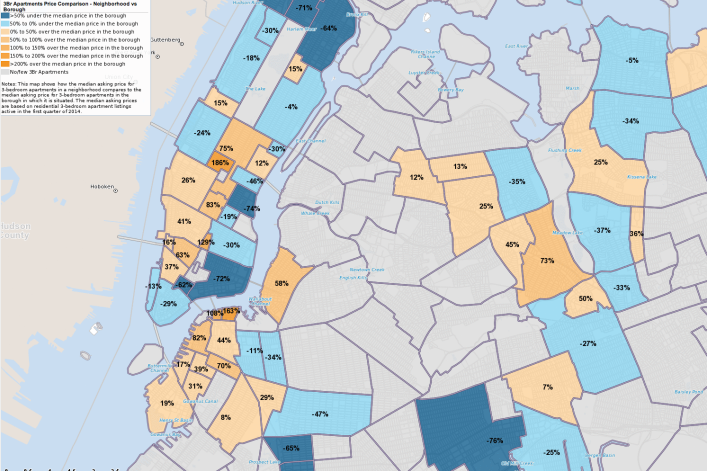Find a (relatively) affordable three-bedroom with this interactive map

Having trouble finding a three-bedroom apartment in New York City? Join the club.
“Everything’s pretty scarce in three-bedrooms right now all over the city,” says Barbara Fox, founder of real estate brokerage Fox Residential.
If you’re also looking for a deal, you’ll have an even steeper climb. So real estate listings site Point2 Homes put together an interactive map to chart the areas in Manhattan, Brooklyn and Queens where you can still find a relative bargain on a three-bedroom place—as well as the neighborhoods where prices are out of control.
The map looks at the median asking price of three-bedrooms on the market in each neighborhood during the first three months of this year, and shows how they stack up against price tags in their borough. Neighborhoods with significantly cheaper asking prices are dark blue, while areas where you’ll pay more are shaded dark orange. Zoom in to see more detailed pricing info.
In Manhattan, some of the cheapest three-bedrooms are available in Kips Bay, where the asking price was 74 percent lower than the Manhattan-wide price tag of $3.4 million. By contrast, not too far away in the Garment District, the median price was a whopping 186 percent higher than the borough.
In Brooklyn, it's Clinton Hill and Crown Heights that appear to have the deals--with asking prices 34 percent and 47 percent lower than the borough, respectively--while Brooklyn Heights and Dumbo are among the most expensive, asking 82 percent and 108 percent above the Brooklyn median of almost $1.24 million.
And a few other pointers as you're playing with the map:
Be prepared to compromise in cheaper areas
Why are some seemingly swanky areas like the Upper West Side more affordable than others? It could be because of the housing that's available in those areas.
The Upper West Side, particularly along the streets between West 65th and West 96th, is dominated by co-ops, many of which don’t have the kind of bells and whistles that command top dollar, says Frances Katzen, a broker at Douglas Elliman. That doesn't mean that plenty of people aren't shopping for a place there.
“I definitely do not feel that the supply and demand issues have loosened up there,” she adds. “In fact, it’s tighter than it’s ever been.”
Other areas, like the Financial District and Midtown West, just haven't gentrified as quickly as places like Tribeca, particularly as the recent economic dowturn depressed prices across the city, Katzen says.
“The problem with a [neighborhood like the] Financial District is it’s the first to recede in a bad market and the last to come back in a good market,” she says.
Even pricey nabes have cheap-ish pockets
In Midtown, the median asking price for a three-bedroom was a staggering $5.94 million, or 75 percent more than the figure for Manhattan overall. Along West 57th Street, you’ll find a “billionaire’s row” of under-construction skyscrapers that are asking stratospheric prices, potentially skewing the numbers, notes Jonathan Miller, president of appraisal firm Miller Samuel. But that doesn't mean that you can't score something for less in another part of the neighborhood.
For example, even though the Upper East Side is nearly on par with prices across Manhattan—the median asking price was $3.25 million, or 4 percent lower than Manhattan's $3.4 million median—you can find “good buys” between East 79th and East 89th Streets and York Avenue and the river, says Fox. “It’s just off the beaten path, but it’s a fantastic neighborhood,” she adds.
Three-bedrooms are scarce in gray areas
Much of the map is gray, representing parts of the city with too few three-bedroom listings to get an accurate read on prices. This doesn’t necessarily mean there are no family-sized homes in Bedford-Stuyvesant or Greenpoint. But if you’re hunting for space, you’ll probably be looking at houses, rather than apartments, Miller says. If you’re set on vertical dwelling, you may want to look elsewhere.
Check out the schools
If you’re looking for a family-sized apartment, you may also interested in the schools in the area. You can check out which areas are dense with education offerings by selecting different map overlays on the left hand side of the map, which will show you the proximity to elementary, junior high and high schools, plus colleges and universities. Zoom in on the map for more detail. You can do the same thing to find police precincts and subway stations.
Still too pricey? Click on “competitively priced neighborhoods” on the left to look at a similar map, but this one pulling sales data for all types of apartments. (You can read more about that map here.)
Related posts:
9 NYC nabes where you can still get a bargain
Moving to NYC? Here's a crash course in finding an apartment here
Buy Curious: A 3-bedroom with a pool for under $2M--can it be done?
7 maps you'll want to consult before you move (and two just for fun)
























